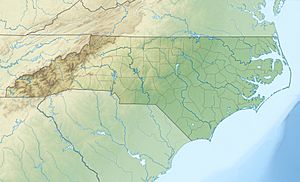Mears Fork facts for kids
Quick facts for kids Mears Fork |
|
|---|---|
|
Location of Mears Fork mouth
|
|
| Other name(s) | Tributary to Haw River |
| Country | United States |
| State | North Carolina |
| County | Guilford |
| Physical characteristics | |
| Main source | divide between Mears Fork, Haw River, and Reedy Fork Summerfield, North Carolina 878 ft (268 m) 36°12′32″N 079°53′57″W / 36.20889°N 79.89917°W |
| River mouth | Haw River about 2 miles south of Midway, North Carolina 699 ft (213 m) 36°14′51″N 079°47′04″W / 36.24750°N 79.78444°W |
| Length | 7.77 mi (12.50 km) |
| Basin features | |
| Progression | northeast |
| River system | Haw River |
| Basin size | 12.59 square miles (32.6 km2) |
| Tributaries |
|
| Bridges | Strawberry Road, Lake Brandt Road, Cedar Ridge Farm Road |
Mears Fork is a stream in Guilford County, North Carolina. It is about 7.77 miles (12.5 km) long. This stream flows into the Haw River, making it a "tributary" or a smaller stream that feeds into a larger one.
Where Mears Fork Flows
Mears Fork starts in a place called Summerfield, North Carolina. This area is in Guilford County, North Carolina. The stream begins where the land divides the water flow between Mears Fork, the Haw River, and another stream called Reedy Fork.
From its start, Mears Fork flows towards the northeast. It continues its journey until it reaches and joins the Haw River. This meeting point is about 2 miles south of a town called Midway, North Carolina.
The Mears Fork Area
The area that Mears Fork drains is called its watershed. This watershed covers about 12.59 square miles (32.6 square kilometers). This means all the rain that falls in this area eventually flows into Mears Fork.
On average, the Mears Fork watershed gets about 45.7 inches (116 cm) of rain each year. About half of the land in this watershed, around 50%, is covered by forests.
Special Natural Places
Experts have studied the Mears Fork watershed and found several important natural areas. These places are special because they have unique plants, animals, or types of forests. Here are some of them:
- Witty Road Wetland: This area has a wetland, which is a place where the land is often wet. It also has a special type of forest that grows near rivers.
- Cummings Dairy Beaver Pond: This spot used to be a beaver pond. Now, it's a "shrub swamp," which means it's a wet area with many bushes and small trees.
- Strader Road Beaver Pond: This is another area that was once a beaver pond.
- Trailing Cedar Farm: This location is very important. It has wetlands and different kinds of forests. You might even find some rare plant or animal species living here!
- Burnt Oaks: This area also has beaver pond wetlands and forests on hillsides.
- Mears Fork at Lake Brandt Road: Here, you can find two types of old, well-grown forests. One is a "Dry-Mesic Oak-Hickory Forest," and the other is a "Mesic Mixed Hardwood Forest."
- Cedar Hollow Alluvial Forest: This place has a "Piedmont Alluvial Forest." This type of forest grows on rich soil deposited by rivers in the Piedmont region.
- Mear Fork at Church Street: Another spot with a mature "Dry-Mesic Oak-Hickory Forest."
- Church Street Ginseng Slope: This area is home to a mature "Mesic Mixed Hardwood Forest."



